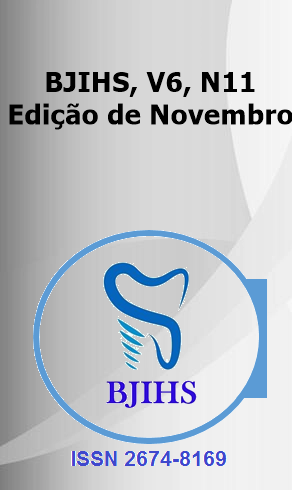Abstract
Diabetes is recognized as one of the most prevalent diseases in the world. In Brazil, it is also a highly prevalent disease, with the country having the fourth largest diabetic population in the world, with an estimated 13 million people living with the disease in the country. Diabetes is a multifactorial disease that causes harm to the physical health of citizens and to the economy of the Brazilian state, with costs that could reach R$27 billion by 2030. Regarding the direct consequences, the main clinical consequences for the patient are the increased risk of acute myocardial infarction, ischemic and hemorrhagic stroke, chronic renal failure, diabetic neuropathy and blindness. The greatest concern regarding the disease is related to its growth in Brazil throughout this century, with a progressive increase shown by global and national surveys. Among the largest studies on the subject is the VIGITEL tracking, which analyzes the health profile of the Brazilian population through telephone calls. Although it is not a completely reliable method for showing the real numbers of the disease, data collection provides a basis for government health planning, and was the basis for the study of this article. According to the VIGITEL survey, there was an increase in the percentage of adults living with diabetes between 2006 and 2021, which went from 5.5% prevalence in 2006 to 9.1% in 2021. When analyzing only the percentage of women, the numbers are even more worrying, with a prevalence of 9.6% of the female population living with the disease. The differences in prevalence between the female and male populations can be discussed based on cultures of distant care, with the male population historically seeking less health care. When talking about educational differences, the population with less time of schooling has a higher percentage of those affected by the disease. The causes are also multifactorial, and range from a lack of knowledge about the disease to financial difficulties in seeking specialized care or diagnostic tests in the private sector. The data collected by the study raises an alert for civil society and those responsible for public health planning, showing that the measures taken so far have not been satisfactory in preventing diabetes.
References
Ministério da Saúde. VIGITEL Brasil 2006-2021: vigilância de fatores de risco e proteção para doenças crônicas por inquérito telefônico: estimativas sobre frequência e distribuição sociodemográfica de prática de atividade física nas capitais dos 26 estados brasileiros e no Distrito Federal entre 2006 e 2021: morbidade referida e autoavaliação de saúde. Ministério da Saúde, Secretaria de Vigilância em Saúde, Departamento de Análise Epidemiológica e Vigilância de Doenças Não Transmissíveis. – Brasília: Ministério da Saúde, 2022 [citado em 26 de outubro de 2024]. Disponível em: http://bvsms.saude.gov.br/bvs/publicacoes/vigitel_brasil_morbidade_autoavaliacao_2006-2021.pdf
GBD 2017 DALYs e colaboradores HALE Anos de vida ajustados por incapacidade (DALYs) globais, regionais e nacionais para 359 doenças e lesões e expectativa de vida saudável (HALE) para 195 países e territórios, 1990-2017: uma análise sistemática para o Estudo da Carga Global de Doenças 2017. Lancet Lond Engl. 2018;392:1859–1922. doi: 10.1016/S0140-6736(18)32335-[ DOI ] [ Artigo gratuito do PMC ] [ PubMed ] [ Google Scholar ].
Pereda PC. Custo anual de diabetes no Brasil pode chegar a R$ 27 bilhões em 2030, diz estudo. [Depoimento] [Internet]. Folha de São Paulo. 2022 ;[citado 2024 nov. 13 ] Disponível em: https://www1.folha.uol.com.br/equilibrioesaude/2022/04/custo-anual-de-diabetes-no-brasil-pode-chegar-a-r-27-bilhoes-em-2030-diz-estudo.shtml
Bahia L. Sociedade Brasileira de Diabetes [Internet]. O alto custo do pé diabético no Brasil - Sociedade Brasileira de Diabetes; 9 ago 2021 [citado 14 nov 2024]. Disponível em: https://diabetes.org.br/o-alto-custo-do-pe-diabetico-no-brasil/.
Reis RCP dos, Duncan BB, Malta DC, Iser BPM, Schmidt MI. Evolution of diabetes in Brazil: prevalence data from the 2013 and 2019 Brazilian National Health Survey. Cadernos de Saúde Pública [Internet]. 2022 May 6;38. Disponível em: https://www.scielo.br/j/csp/a/4YWtmtvQkgFm3mmQ4f7kxDr/?lang=en
Duncan BB, Cousin E, Naghavi M, Afshin A, França EB, Passos VM de A, et al. The burden of diabetes and hyperglycemia in Brazil: a global burden of disease study 2017. Population Health Metrics. 2020 Sep;18(S1). Disponível em: https://pmc.ncbi.nlm.nih.gov/articles/PMC7526086/#CR2

This work is licensed under a Creative Commons Attribution 4.0 International License.
Copyright (c) 2024 Karen Mariano Rodrigues , Jamile Carvalho Rodrigues , Antônio Vidal de Lima Filho , Bianca Oliveira Bomfim , Eduarda Hamerski Swidzikiewicz , Ana Elisa Peres Bortolozzo , Matheus Lucas Meireles Franklin , Gabriella Tolentino , Bruno Rheuly Bonfá Camillo , Letícia Bonfim Silveira , Marillia Laís Chagas Viana , Rafael Lino Figuerêdo

